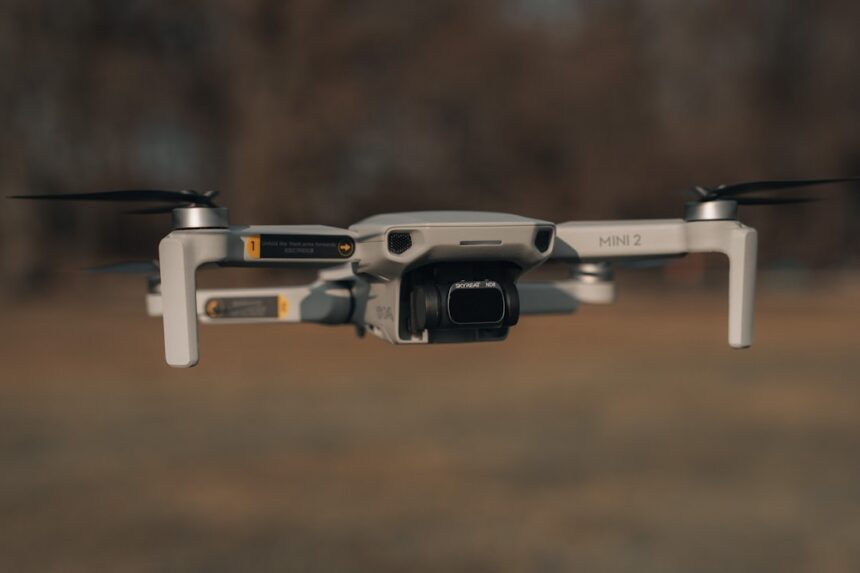In recent years, the emergence of autonomous drones has sparked significant interest and concern across various sectors, including military, commercial, and civilian domains. These unmanned aerial vehicles (UAVs) are equipped with advanced technologies that allow them to operate independently, making decisions based on pre-programmed algorithms and real-time data. While the potential applications of autonomous drones are vast and varied, ranging from delivery services to surveillance, their capabilities also raise alarming questions about security and safety.
The increasing sophistication of these drones has led to a growing recognition of the threats they pose, particularly in terms of their potential misuse by malicious actors. The rise of autonomous drones has not only transformed the landscape of aerial operations but has also introduced new challenges for governments, law enforcement agencies, and security organizations. As these drones become more accessible and affordable, the risk of them being employed for nefarious purposes escalates.
The implications of this technology extend beyond mere privacy concerns; they encompass issues related to national security, public safety, and ethical considerations. Understanding the multifaceted nature of autonomous drone threats is essential for developing effective strategies to mitigate their risks and ensure a secure future.
Key Takeaways
- Autonomous drones pose a significant threat to national security and public safety due to their potential use in attacks and surveillance.
- The risks and dangers of autonomous drones include unauthorized surveillance, smuggling of contraband, and potential use in terrorist attacks.
- Current regulations and laws governing autonomous drones are limited and often struggle to keep up with the rapid advancements in drone technology.
- Technology plays a crucial role in mitigating autonomous drone threats through the development of detection and defense systems.
- Strategies for detecting and defending against autonomous drones include the use of radar systems, jamming technology, and drone detection software.
The Potential Risks and Dangers of Autonomous Drones
The potential risks associated with autonomous drones are manifold and complex. One of the most pressing concerns is their ability to be weaponized. As technology advances, the prospect of drones being equipped with explosives or other harmful payloads becomes increasingly feasible.
This capability poses a significant threat to public safety, as a single drone could potentially cause mass casualties if deployed in a crowded area or against critical infrastructure. The anonymity and precision offered by autonomous drones make them attractive tools for terrorists and other malicious entities seeking to inflict harm without direct confrontation. Moreover, the use of autonomous drones raises significant privacy issues.
With their ability to conduct surveillance over vast areas without human oversight, these drones can infringe upon individuals’ rights to privacy and freedom. The potential for unauthorized data collection and monitoring is a growing concern among civil liberties advocates. Additionally, the risk of hacking or cyberattacks on drone systems presents another layer of danger.
If a drone’s control system is compromised, it could be manipulated to carry out harmful actions or gather sensitive information, further exacerbating the threats posed by this technology.
Current Regulations and Laws Governing Autonomous Drones

As the use of autonomous drones proliferates, regulatory frameworks have struggled to keep pace with technological advancements. In many countries, existing laws governing aviation and unmanned aerial vehicles are outdated and ill-equipped to address the unique challenges posed by autonomous systems. Regulatory bodies are tasked with creating guidelines that ensure safety while fostering innovation; however, striking this balance has proven difficult.
In the United States, for instance, the Federal Aviation Administration (FAA) has implemented regulations for commercial drone use but has yet to establish comprehensive rules specifically addressing autonomous operations. Internationally, the situation is similarly fragmented. Different countries have adopted varying approaches to drone regulation, leading to inconsistencies that complicate enforcement and compliance.
Some nations have embraced more stringent measures, while others have taken a more laissez-faire stance, allowing for greater experimentation with drone technology. This lack of uniformity creates challenges for law enforcement agencies tasked with monitoring drone activities and responding to incidents. As the technology continues to evolve, there is an urgent need for cohesive international standards that address the risks associated with autonomous drones while promoting responsible usage.
The Role of Technology in Mitigating Autonomous Drone Threats
| Technology | Role in Mitigating Autonomous Drone Threats |
|---|---|
| Radio Frequency (RF) Detection Systems | Detect and track unauthorized drones in restricted airspace |
| Drone Jammers | Disrupt communication between drones and their operators |
| Geofencing Technology | Prevent drones from entering restricted areas through GPS-based virtual boundaries |
| Anti-Drone Drones | Capture or disable unauthorized drones using nets or other methods |
| Artificial Intelligence (AI) Systems | Analyze drone behavior and identify potential threats |
Technology plays a crucial role in both enhancing the capabilities of autonomous drones and mitigating the threats they pose. On one hand, advancements in artificial intelligence (AI), machine learning, and sensor technologies have enabled drones to operate with remarkable autonomy and efficiency. These innovations have opened up new possibilities for various applications but have also made it easier for malicious actors to exploit these capabilities for harmful purposes.
Conversely, technology can also serve as a powerful tool for countering the risks associated with autonomous drones. For instance, developments in drone detection systems have emerged as a critical component in safeguarding airspace from unauthorized UAVs. These systems utilize radar, radio frequency identification (RFID), and visual recognition technologies to identify and track drones in real-time.
By integrating these detection capabilities with automated response systems, authorities can effectively neutralize potential threats before they escalate into dangerous situations.
Strategies for Detecting and Defending Against Autonomous Drones
To effectively address the challenges posed by autonomous drones, a multi-faceted approach is necessary. Detection strategies must be robust and adaptable to keep pace with evolving drone technologies. One promising avenue involves the use of advanced radar systems that can differentiate between various types of aerial vehicles, allowing for accurate identification of unauthorized drones.
Additionally, integrating artificial intelligence into detection systems can enhance their ability to predict drone behavior and respond proactively. Defensive measures against autonomous drones also require innovative solutions. Jamming technologies can disrupt a drone’s communication signals, rendering it inoperable; however, this approach raises concerns about collateral damage and unintended consequences.
More sophisticated methods involve deploying counter-drone systems that can intercept or disable rogue UAVs through kinetic means or electronic warfare tactics. Collaboration between government agencies, private sector companies, and research institutions is essential to develop effective strategies that prioritize public safety while minimizing risks associated with countermeasures.
The Impact of Autonomous Drones on National Security

The implications of autonomous drones extend far beyond individual incidents; they pose significant challenges to national security as well. Governments around the world are grappling with how to address the potential threats posed by these technologies in both domestic and international contexts. The ability of non-state actors to acquire and deploy autonomous drones raises concerns about asymmetric warfare, where smaller groups can leverage advanced technologies to challenge traditional military forces.
Moreover, the proliferation of autonomous drones complicates intelligence-gathering efforts for national security agencies. The ease with which these drones can be deployed makes it difficult for authorities to monitor airspace effectively and identify potential threats before they materialize. As nations invest in developing their own drone capabilities, there is a growing need for international cooperation to establish norms and agreements governing the use of autonomous drones in conflict zones and beyond.
The Future of Autonomous Drone Technology and Threats
Looking ahead, the future of autonomous drone technology is poised for rapid evolution. As advancements in AI and machine learning continue to progress, drones will likely become even more capable of performing complex tasks autonomously. This evolution presents both opportunities and challenges; while enhanced capabilities can lead to innovative applications in fields such as agriculture, logistics, and disaster response, they also increase the potential for misuse.
The threat landscape surrounding autonomous drones will likely become more intricate as well. As more individuals gain access to advanced drone technologies, the risk of malicious use will escalate. Governments must remain vigilant in monitoring developments in this space while fostering collaboration between industry stakeholders to ensure responsible innovation.
The challenge lies in balancing technological advancement with effective regulation and oversight to mitigate risks while harnessing the benefits that autonomous drones can offer.
Case Studies of Autonomous Drone Incidents and Attacks
Examining real-world incidents involving autonomous drones provides valuable insights into the potential dangers associated with this technology. One notable case occurred in Venezuela in 2018 when an assassination attempt was made against President Nicolás Maduro using explosive-laden drones during a public event.
Another significant case involved a series of unauthorized drone flights over major airports in London in 2018, which caused widespread disruption and grounded flights for several days. This incident underscored the vulnerabilities inherent in air traffic management systems when faced with rogue UAVs operating autonomously. Such events serve as stark reminders of the urgent need for effective detection and response strategies to safeguard public safety and national security.
The Ethical and Moral Implications of Autonomous Drone Use
The rise of autonomous drones brings forth profound ethical and moral questions that society must grapple with as this technology becomes more prevalent. One major concern revolves around accountability: who is responsible when an autonomous drone causes harm? The lack of human oversight raises complex legal dilemmas regarding liability in cases of accidents or malicious use.
Additionally, there are ethical considerations surrounding privacy rights and surveillance capabilities inherent in autonomous drone technology. The potential for mass surveillance raises questions about civil liberties and individual freedoms in an increasingly monitored society. Striking a balance between security needs and protecting citizens’ rights will require thoughtful dialogue among policymakers, technologists, ethicists, and the public at large.
Collaboration and Cooperation in Addressing Autonomous Drone Threats
Addressing the challenges posed by autonomous drones necessitates collaboration across various sectors and stakeholders. Governments must work closely with industry leaders to develop comprehensive regulatory frameworks that promote responsible innovation while ensuring public safety. Engaging with academia can also foster research initiatives aimed at understanding the implications of drone technology on society.
International cooperation is equally vital in tackling cross-border threats posed by autonomous drones. Establishing global norms governing their use can help mitigate risks associated with their proliferation while promoting responsible practices among nations. Collaborative efforts among law enforcement agencies can enhance information sharing regarding emerging threats and best practices for detection and response.
Navigating the Rise of Autonomous Drone Threats
As autonomous drone technology continues to advance at an unprecedented pace, society faces both exciting opportunities and daunting challenges. The potential benefits offered by these innovations must be weighed against the risks they pose to public safety, national security, and individual rights. A proactive approach that emphasizes collaboration among stakeholders—governments, industry leaders, researchers, and civil society—is essential for navigating this complex landscape.
By fostering dialogue around ethical considerations, developing robust regulatory frameworks, and investing in advanced detection technologies, society can work towards harnessing the benefits of autonomous drones while mitigating their threats. As we move forward into an era defined by rapid technological change, it is imperative that all stakeholders remain vigilant in addressing the multifaceted challenges posed by autonomous drone threats to ensure a secure future for all.
In the rapidly evolving landscape of modern warfare, the emergence of autonomous drone threats has become a significant concern for military strategists worldwide. As nations strive to adapt to these new challenges, understanding the implications and potential countermeasures is crucial. A related article that delves into the broader context of technological advancements in warfare can be found on In The War Room. This resource provides valuable insights into how military forces are rethinking their strategies to address the complexities introduced by autonomous systems, ensuring they remain prepared for future conflicts.
FAQs
What are autonomous drone threats?
Autonomous drone threats refer to the potential risks and dangers posed by unmanned aerial vehicles (UAVs) that operate without direct human control. These drones can be equipped with various payloads, such as explosives, chemical agents, or surveillance equipment, and can be used for malicious purposes.
How are autonomous drone threats being addressed?
To address autonomous drone threats, various countermeasures are being developed, including drone detection systems, jamming technologies, and kinetic solutions such as anti-drone guns or nets. Additionally, regulations and laws are being implemented to control the operation of drones and prevent misuse.
What are the challenges in adapting to autonomous drone threats?
Adapting to autonomous drone threats presents several challenges, including the rapid advancement of drone technology, the difficulty of detecting and intercepting small drones, and the need to balance security measures with the legitimate use of drones for commercial and recreational purposes.
What industries are most vulnerable to autonomous drone threats?
Industries such as critical infrastructure, public safety, defense, and event management are particularly vulnerable to autonomous drone threats due to the potential for disruption, surveillance, or physical harm caused by malicious drone operations.
What role do regulations play in addressing autonomous drone threats?
Regulations play a crucial role in addressing autonomous drone threats by establishing guidelines for drone operation, defining no-fly zones, and imposing penalties for unauthorized or malicious drone activities. Regulatory frameworks also promote the development and deployment of counter-drone technologies.




